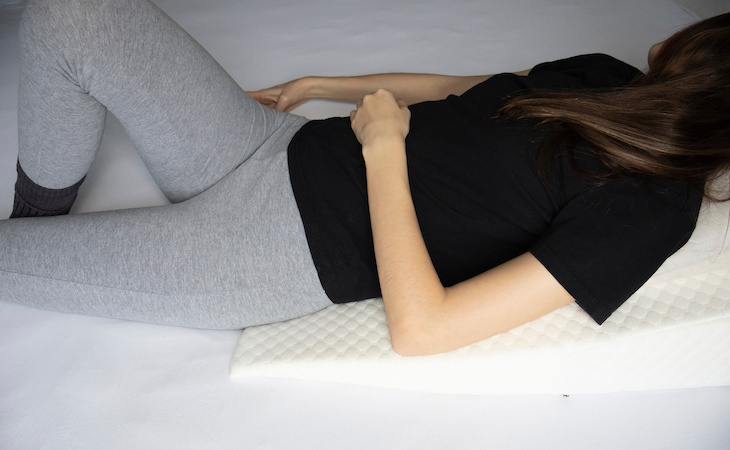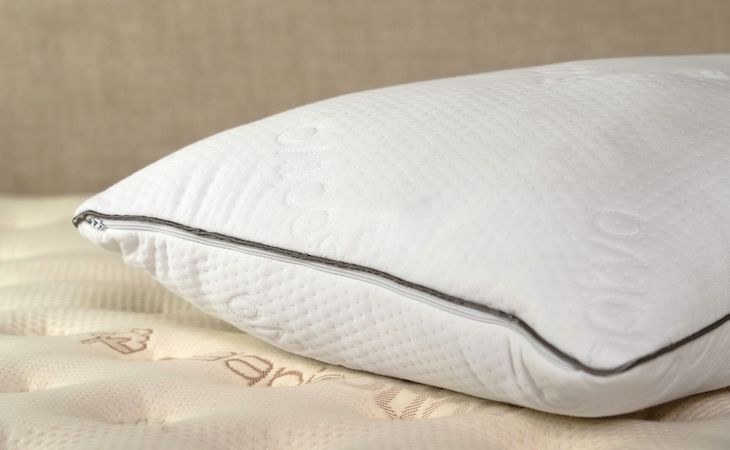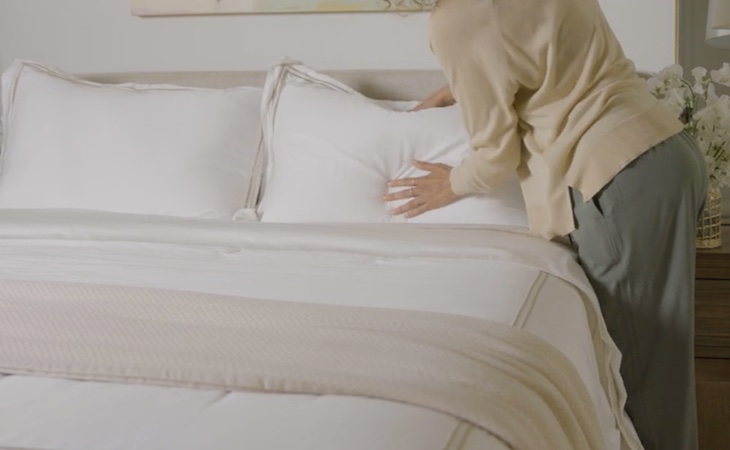Among the dizzying variety of pillows available today, you’ve likely seen those triangle-shaped wedges that look like oversized chunks of cheese. If you’ve ever wondered how to sleep on a wedge pillow and whether you need one at all, this guide is for you.
Wedge pillows are used to elevate a part of your body and make you more comfortable while you sleep. That can be useful in a variety of situations and for certain health conditions, such as snoring, sleep apnea, and acid reflux.
But even if you don’t suffer from any of these, you can still greatly benefit from using a wedge pillow. Among other things, you can also use it to prop yourself up if you’re working from home on the couch or in bed. Read on to find out how a modest wedge pillow can improve your sleep.
What is a wedge pillow?
A wedge pillow is a triangular orthopedic pillow, typically made from polyfoam or memory foam, that’s used to elevate a part of the sleeper’s body for increased comfort.
Depending on where you place it, the wedge pillow’s sloped design can lift a part of your body from 30 to 45 degrees, which can be extremely helpful for alleviating the symptoms of various health conditions.
Benefits of using a wedge pillow
There are quite a few conditions that could benefit from using a wedge pillow.
Acid reflux
Acid reflux, or Gastroesophageal Reflux Disease (GERD), occurs when acid from your stomach moves up into your esophagus, throat, and mouth, causing pain, discomfort, and sleep disturbance.
It often occurs at night because it’s easier for stomach acid to move when your body is in a horizontal position. Placing a wedge pillow to elevate your upper back can prevent this from happening as it will help gravity keep the acid down.
Snoring
Snoring occurs when the muscles of your throat relax during sleep, narrowing your airways and causing the tissues to vibrate as the air passes through them. Sleeping in an elevated position with a wedge pillow behind your head and upper back can help airways remain open and therefore prevent snoring.
Sleep apnea
Sleep apnea is a sleep disorder that occurs when the muscles in your throat relax too much, blocking the airways and causing a momentary cessation of breathing. You then wake up, gasp for air, and go back to sleep—several times per night.
The condition prevents the person from getting quality sleep and can cause high blood pressure and even lead to an increased risk of heart attack and stroke. Elevating your head with the help of a wedge pillow can mitigate the symptoms of this disorder.
Pregnancy
Studies show that 94% of pregnant women struggle to get quality sleep. That’s partially due to hormonal changes and emotional challenges, but it’s also because the weight of the baby bump puts pressure on your back making it difficult to sleep in certain positions.
Wedge pillows can help here as well, either by elevating the upper body to help relieve back pain or while used for side sleeping to support the weight of the stomach.
Back pain
Those suffering from occasional or chronic back pain can also benefit from sleeping on a wedge pillow. Elevating your upper body while sleeping can decrease pressure on the lumbar spine, significantly reducing lower back pain.
Asthma
Asthma is a disease that affects the lungs and airways, causing serious breathing difficulties. Your asthma symptoms might worsen during the night due to increased pressure on the airways, especially if you sleep on your back. Again, elevating your upper body may help keep your airways open, prevent mucus buildup, and therefore help you breathe more freely as you sleep.
Congestion
Even if your breathing difficulty isn’t due to asthma or sleep apnea but to congestion related to cold and flu or allergies, sleeping flat on your back can make breathing more challenging. Elevating your body with a wedge pillow can help prevent mucus buildup, allowing you to breathe more easily.
Post-operative discomfort
Wedge pillows can help relieve discomfort for people who’ve recently had surgery. For example, elevating an injured lower limb can help prevent blood from pulling and can help take pressure off it. Wedge pillows may also make it easier to get up and lay down. Of course, you should always consult your doctor before using one.
How to use a wedge pillow
If you’re wondering how to sleep on a wedge pillow, there are a few ways. Generally, wedge pillows are quite versatile and can be used in a variety of ways depending on your sleeping position.
Elevate your upper back
Placing a wedge pillow behind your head and upper back can help with any respiratory issues and help mitigate many other health conditions, such as acid reflux and even back pain.
Simply place the large side of the pillow toward the head of the bed, allowing your head and upper back to lie on it at an angle, keeping your lower body flat against the bed. While this might be particularly useful for back sleepers, side sleepers may also find it comfortable to sleep on a wedge pillow in this position with your upper body on a slight incline. However, you may need an extra pillow on top for neck and head support.
Elevate your legs
If you want to use the wedge pillow to elevate your legs, you can place the thicker end of the pillow toward your hips and the thinner part toward the foot of the bed, so that your knees are on the edge of the pillow. This may help improve blood circulation in your legs and feet, reduce back and leg pain, and improve spinal alignment.
Elevate your belly
If you’re pregnant and want to use the wedge pillow to support your growing belly when side sleeping, place it under your stomach with the thinner part of the pillow closer to you.
Upright recline
Finally, you don’t even need to be sleeping to benefit from your wedge pillow. It can also be great if you like to read or watch TV in bed. Simply place the pillow vertically upright behind your bed, with the wide end of the pillow on your mattress and the thin part toward your head, and enjoy your favorite TV show without worrying about neck pain!
FAQs
How do you sleep comfortably with a wedge pillow?
Depending on your sleeping position, you can use a wedge pillow in a variety of ways to make you feel more comfortable as you sleep. For instance, placing it under your head will elevate your upper body, while placing it under your knees will elevate your legs. Every body is unique, so feel free to experiment with your wedge pillow to find ways to help you sleep most comfortably.
How do you sleep on a wedge pillow for acid reflux?
If you want to use your wedge pillow to help with acid reflux, place it behind your head and upper back (with the thicker part of the wedge towards the head of the bed) so that you’re sleeping on a slight incline. This position will help gravity keep your stomach acid down and prevent it from moving up into your esophagus and throat.
How do you sleep on a wedge pillow without sliding down?
Sliding down the wedge pillow may happen because of slippery clothes or pillowcases—or simply because of gravity. If switching to a less slippery pillow case doesn’t help your sliding problem, you may place an additional pillow under your knees to help counteract the downward gravitational pull caused by the wedge pillow behind your upper back.
Where do you place a wedge pillow?
You can place a wedge pillow in several ways, depending on which part of your body you want to elevate. Place it at the top of the bed to create a slight incline for your upper back, at the bottom of the bed to raise your knees, or simply stand it on your bed behind your back to lean against if you’re watching TV or reading in bed.
Suffering from neck pain? The right pillow can make all the difference. Here’s how to choose the best pillow for neck pain.




